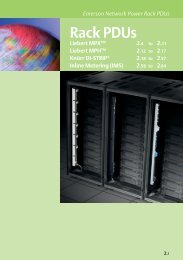100 mm
100 mm
100 mm
- No tags were found...
You also want an ePaper? Increase the reach of your titles
YUMPU automatically turns print PDFs into web optimized ePapers that Google loves.
ELECTRO-TECHNOLOGY FOR INDUSTRYTechnologyPerception of the brightness of light for warnings and alarmsA few tips to assist you in selecting the right visual signalingdevices:Doubling the distance reduces the light power by 75 %to 1/4 of its strength. If the distance is quadrupled, thelight power is reduced to 1/16.Visual alarms are ideal when there is a direct (unobstructed)line of sight between the beacon and theobserver.Refl ected light can be perceived inadequately.In an alarm area (dangerous condition, i<strong>mm</strong>ediate action),the beacon will also be perceived without directvisual contact provided that the light intensity of thealarm device is 10 times brighter than the ambientlight.In a warning area (critical condition, intervene), the signalwill be perceived adequately via direct visual contactor refl ection provided that the light intensity of thewarning device is 5 times brighter than the ambientlight.Optical and electronic monitoringMonitoring of visual alarm devices plays a very importantrole, especially in the case of safety-relevant applications.Monitoring is offered in two different technicalversions.One method is to monitor the correct function of afl ashing light by opto-electronic means. The light fl ashfrom the fl ashing light is fed via an optical fi bre to aphototransistor, which converts the optical impulse toan electrical impulse. The optical fi bre is located in thehousing of the flashing light and directed downwards,which excludes false triggering due to the effect ofdaylight. Additionally, any fl ashing light with a 1 Hz fl ashrate can be retrofitted with an external fl ash monitor.The downstream circuitry evaluates the pulse and itsregular repetition.As soon as the operating voltage is applied, the evaluationrelay closes the error contact. If the operatingvoltage fails, the relay opens i<strong>mm</strong>ediately. This methodof operation represents the fail-safe normally-closedcircuit function and guarantees an alarm even if theoperating voltage fails. On the other hand, the errormessage contact serves the continuative alarming,e.g. in an error message line, or the direct blocking offurther machine processes. It is possible to relay theerror alarm as a normally-closed function. The secondmethod of electronic monitoring is to integrate a fl ashmonitor in the processor of the fl ashing beacon. Inthis case the regular charging and discharging of thefl ashing beacon capacitor is monitored. If one status isnot present, an error message is relayed via a fl oating,normally-closed contact.Inrush current limitationVisual alarm devices can draw a greatly increased initialcurrent for a very short period of time. This is due to thecircuit-related input capacity. This can lead an overloadof the relay contacts at the moment when power isturned on and to the premature triggering of overcurrentcircuit breakers. For special requirements, Pfannenbergcan supply you with visual alarm devices that are factoryfi tted with an initial current limiter. Pfannenberg alsooffers external current limiting modules, so-called softstartmodules (SSM), for retrofitting or supplementingvisual signaling devices.Example of the current curve withand without a soft-start moduleAmpsî up to 12 Awithout SSMwith SSM0 1 2 3 4 5 6 7 8 9 10 11 12 msCurrent limitation 0.7 – 1.5 A25
















